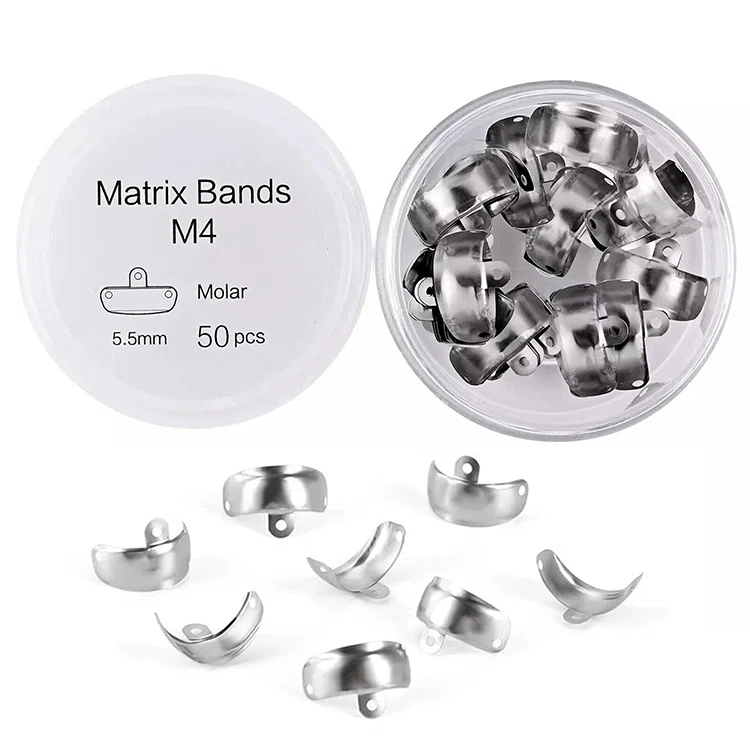
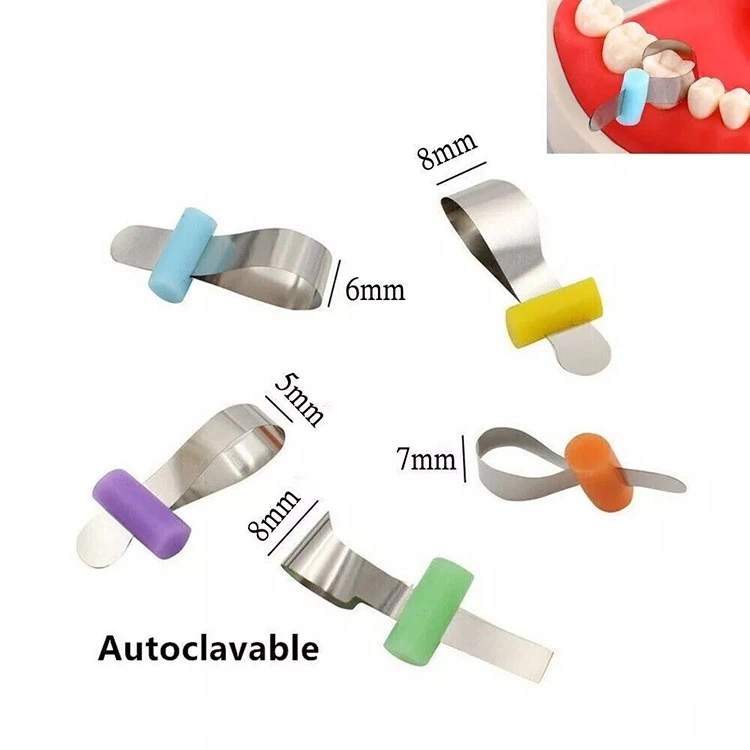
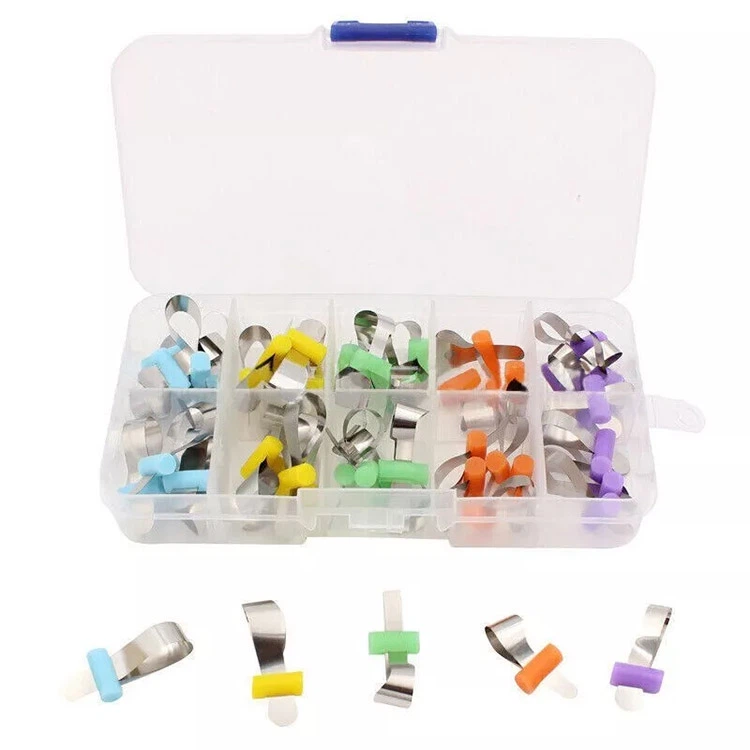
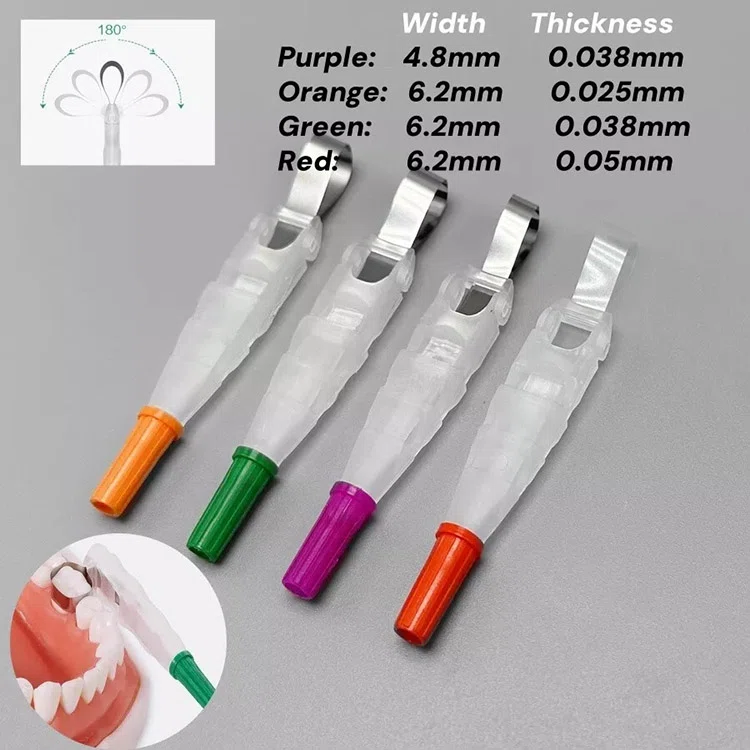
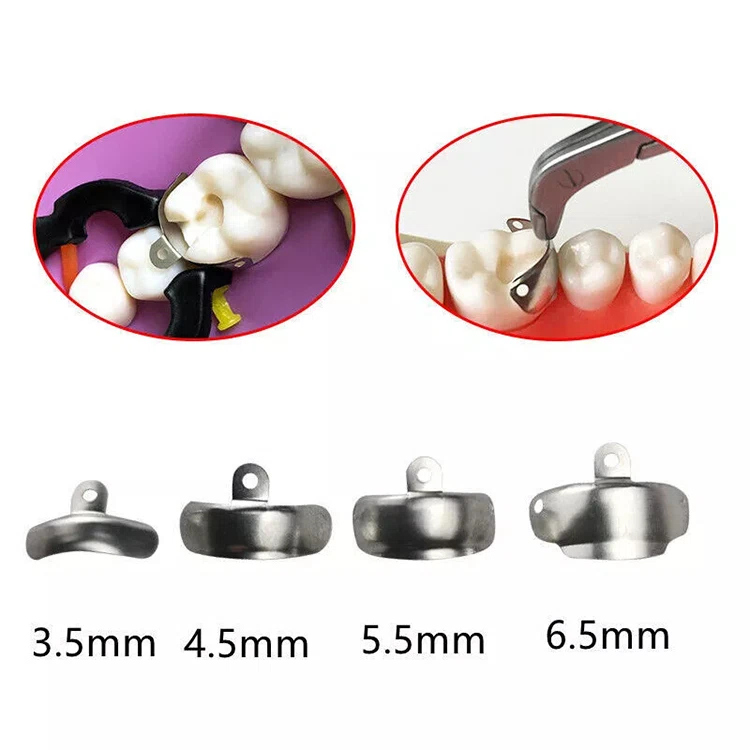
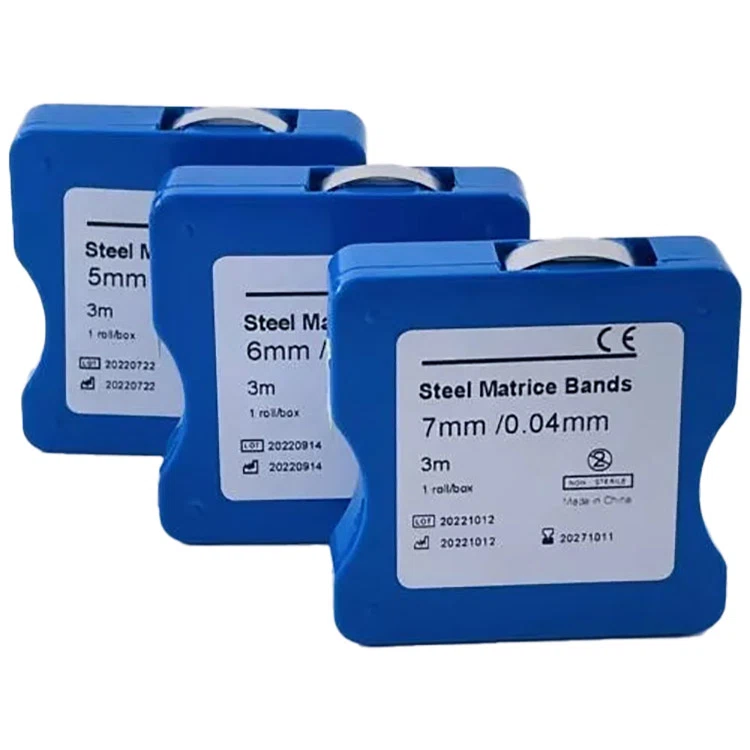
歯科用マトリックスバンド
- 特別な補強マチリアルは、適切な強度と弾力性を保証します
- 良好な弾力性と靭性, 良いクランプ力, 繰り返し使用後の不変性
- より大きな曲率は、歯をより安定に包み、フィットすることができます
- 樹脂材料は、良好な弾力性と回復力を持っています, 変形しません
- オートクレーブ可能
マトリックスバンドは、歯科修復および歯列矯正治療で使用されるステンレス鋼または医療用グレードのプラスチックデバイスです. それらは、臨床処置中に修復材料の成形と形成を支援するために、歯の周りに一時的な封じ込め壁を作成します.
マトリックスバンドは、歯の周りに明確な境界と形状を提供します, 修復材料を指定された領域に正確に埋めることができます, その結果、理想的な歯の形が復元されます.
マトリックスバンドカテゴリ
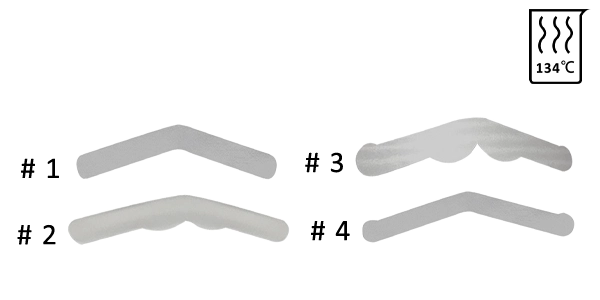
| 広い: #2 厚さ: 0.04mm(0.0015") |
| 広い: #2 厚さ: 0.05mm(0.002") |
| 標準, #1 厚さ: 0.04mm(0.0015") 幅: 6.5mm |
| 標準, #1 厚さ: 0.05mm(0.002") 幅:6.5mm |
| 広い #3 厚さ: 0.04mm(0.0015") |
| 広い #3 厚さ: 0.05mm(0.002") |
| 広い #13 厚さ: 0.04mm(0.0015") |
| 広い #13 厚さ: 0.05mm(0.002") |
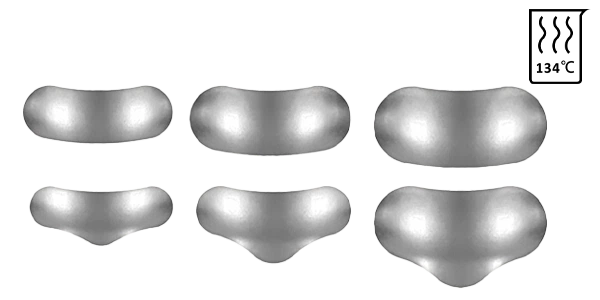
| No.1, 難しい, 小臼歯, 広い: 4.5mm, 厚さ: 0.038mm |
| No.2, 難しい, モル, 広い: 5.5mm, 厚さ:0.038mm |
| No.3, 難しい, 背の高い臼歯, 広い: 6.5mm, 厚さ: 0.038mm |
| No.4, 難しい, 拡張付き透過性, 広い: 5mm, 厚さ:0.038mm |
| No.5, 難しい, 拡張付きモル, 広い: 6.5mm, 厚さ:0.038mm |
| No.6, 難しい, 延長された背の高い臼歯, 広い: 8.5mm, 厚さ: 0.038mm |
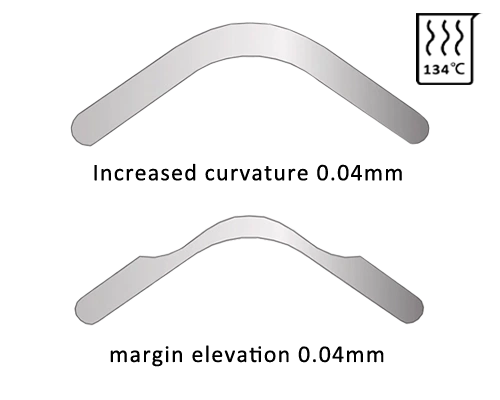
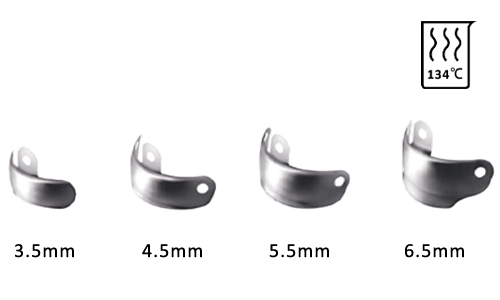
GD-5694セクショナルマトリックスバンド
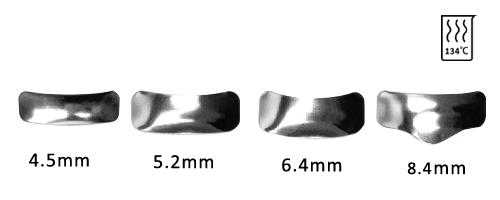
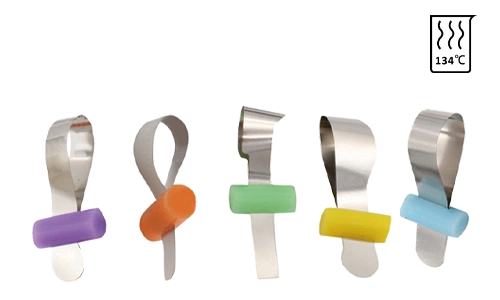
オートクレイビング可能な製品のみ
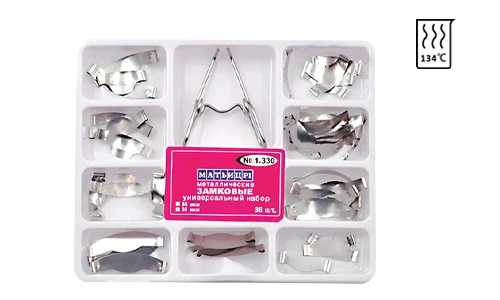
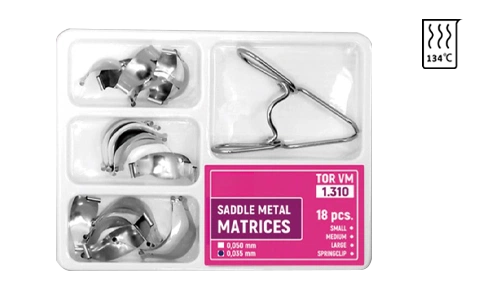
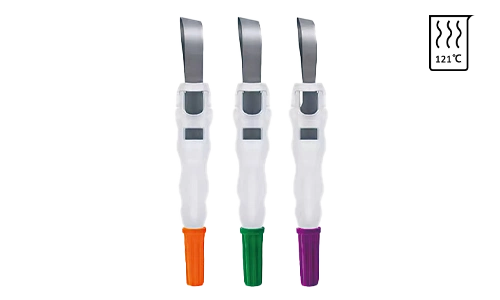
GD-5702リテーナーとマトリックス
| ステンレス鋼 |
| オレンジ: 広い6.2mm, 厚さ0.025mm, ウィングレスまたはウィング付き |
| 緑: 広い6.2mm, 厚さ0.038mm, ウィングレスまたはウィング付き |
| 紫: 幅4.8mm, 厚さ0.038mm, ウィングレスまたはウィング付き |
| 赤: 広い6.2mm, 厚さ0.075mm, ウィングレスまたはウィング付き, マイラー |
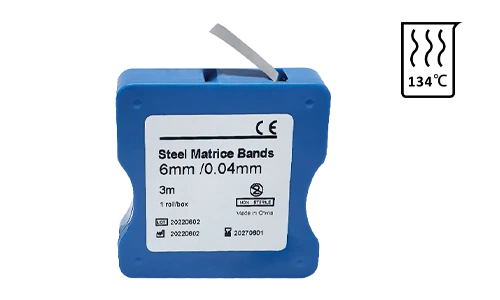
| 広い: 5mm, 厚さ: 0.025mm, 長さ: 3m |
| 広い: 5mm, 厚さ: 0.04mm, 長さ: 3m |
| 広い: 5mm, 厚さ: 0.05mm, 長さ: 3m |
| 広い: 6mm, 厚さ: 0.025mm, 長さ: 3m |
| 広い: 6mm, 厚さ: 0.04mm, 長さ: 3m |
| 広い: 6mm, 厚さ: 0.05mm, 長さ: 3m |
| 広い: 7mm, 厚さ: 0.025mm, 長さ: 3m |
| 広い: 7mm, 厚さ: 0.04mm, 長さ: 3m |
| 広い: 7mm, 厚さ: 0.05mm, 長さ: 3m |
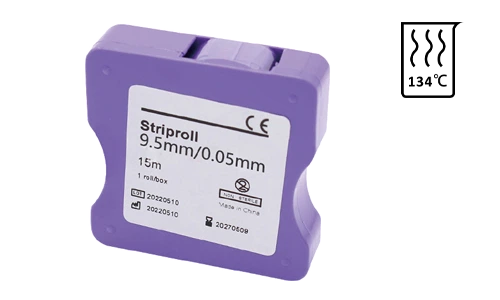
マトリックスバンドは、患者の歯に応じてさまざまなサイズと形状で利用でき、それらを選択します, 歯科医が回復結果を正確に制御するのを支援します. マトリックスバンドは、併用することもできます 歯のくさび 修復材料の厚さを制御します, 充填材が厚すぎたり薄すぎたりするのを避ける.
医療技術の進歩, マトリックスバンドのデザインはよりインテリジェントになります, 修復における精度と有効性をさらに高める. 物質科学の進化は、より快適で耐久性のある新しい素材で構築されたマトリックスバンドにもつながります. 詳細, お問い合わせください.
歯科用マトリックスバンドの種類
セクションマトリックスバンド
断面マトリックスバンドはクラス II およびクラス III の窩洞修復に最適です, 特に奥歯. 事前に設計された円弧は歯の解剖学的構造によく適応します。, 自然な近位接触を生み出し、突出を防ぎます. 薄くて丈夫なステンレス製なので狭い場所でも安定性を維持できます。. これは、歯科の詰め物に使用される複合材料の結合にとって非常に重要です。.
円周マトリックスバンド
円形 (完全な円) マトリックス バンドは完全な被覆修復に使用され、クラウンの準備や大きなクラス I 窩洞の後処理に適用できます。. ステンレス鋼または使い捨てプラスチック製, 360°のサラウンドサポートを提供し、材料を均等に配置し、輪郭を修復します。.
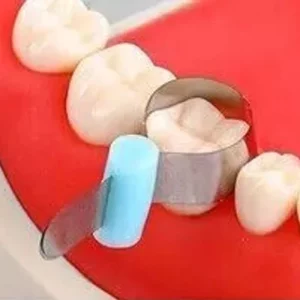
リテーナーマトリックスバンド
奥歯冠の作製や大規模な修復など比較的長時間の手術時間を必要とする場合によく使用されます。. また、360°サラウンドサポートも提供し、内蔵ロック設計が付属しています。, サポートを補助するための歯科用ウェッジの必要性を排除します. 長期的な状態維持を提供できます。, 修復物が完全に硬化するのを待っています.
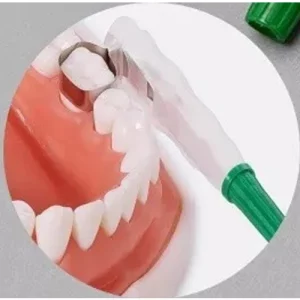
樹脂ストリップロール
レジンストリップロールはプラスチック製のマトリックスバンドの一種です, 必要なだけカットされます. さらに, 樹脂ストリップロールは使い捨てです. 使用後の洗浄や消毒を考える必要がありません。. とても便利で時間の節約になります.
歯科医が当社の歯科用マトリックスバンドを信頼する理由
- 安全かつ無菌: 当社のベーステープはすべてFDAおよびCE規格に準拠しています。. 工場から出荷される前にすべて厳格な滅菌処理が行われ、すべて高温高圧滅菌に対応しています. 交差感染を防ぐために, また、使用の前後に厳密に滅菌することをお勧めします。.
- 耐久性: ステンレススチールのマトリックスバンドは、配置および取り外し時の変形に非常に優れています。, 繰り返し使用しても優れたパフォーマンスを保証できます.
- 高精度: 当社のマトリックスバンドは、複数のエッジプレスプロセスを経て、優れた品質を保証します。, 滑らかでバリのないエッジ. 密閉された環境を作り出すことができる, 歯科用充填材の漏れを防ぐ, 術後の歯の過敏症や二次う蝕の発生率を減らします。.
歯科用マトリックスバンドの正しい使用方法
適切なタイプとサイズを選択してください:
試験後, X線フィルムと充填が必要な歯の位置に基づいて. 歯科用マトリックスバンドの種類とサイズを選択してください. 奥歯の深い虫歯を埋める必要がある場合, リテーナーマトリックスバンドを選択するのが最善です, 安定した状態を長期間維持できる. 小臼歯のくさび状欠損の場合, セクションマトリックスバンドは、歯間ウェッジと組み合わせて使用して連携することができます。. これは、小臼歯の視野が良好で、くさび形欠損の面積が比較的小さいためです。, 歯の本体の一部だけを囲む必要があります.
安全な配置:
マトリックスバンドを使用して歯周領域を安定させる場合, 歯肉の端と面一であることを確認し、歯肉に埋め込まれて患者に不快感を与えないように過度の力を加えないでください。.
輪郭を確認してください:
修復材を充填する前に, マトリックスバンドで囲まれた輪郭が完全で自然であることを確認してください, そして歯によくフィットします. 過剰充填または充填不足がその後の処理を妨げないようにする.
慎重に取り外してください:
補修材硬化後, マトリックスバンドをゆっくりと取り外します. 次に、エッジ領域をチェックして修復効果を判断します。.
マトリックスバンドに関連する問題点を解決する
お客様からのフィードバックによると, 最適化には 3 つの大きな課題があります
1. 空間適応の難しさ:
臼歯の歯間う蝕の修復中, マトリックスバンドが狭い隙間に収まらないか、挿入時に操作視野を妨げます。.
最適化計画: 当社の GD-5696 セクショナル マトリックス バンドはアップグレードされ、数千の患者の臼歯サイズと歯間スペースの調査に基づいて 6 つのモデルに差別化されました。. 詳しい仕様については, 上の表を参照してください. 基本的にカバーします 90% 患者の’ 臼歯サンプル. 歯間臼歯修復の際に選択に迷う必要はもうありません.
2. エッジリークの問題:
充填後, 接合エッジにはバリや大きな突起があることが常にわかります。, その後の研磨と研削に多くの時間がかかります. 成形シートの端がしっかりとシールされていないことが原因でした.
最適化計画: この種の問題は、成形シートのロック圧力が不十分であることが主な原因です。. 時々, 補助として歯間ウェッジを使用する場合, 圧力が不均一である, その結果、エッジのシールが不十分になり、修復材が溢れ出す可能性があります。. 後に開発したGD-5702リテーナーマトリックスバンドはこの問題を効果的に解決します。. 360°サラウンドロックを提供し、均一な圧力を長時間維持できます。.
3. 素材の耐久性:
通常のステンレス成形板は3回消毒すると変形してしまう.
最適化計画: 316L医療用ステンレス鋼素材にアップグレード, 134℃高圧蒸気滅菌対応, 加工後の形状安定性を維持する 20 滅菌サイクル.
FAQ
前歯修復用, 歯の直径を参照できます: 中切歯用, 小さいタイプを選ぶ (幅5-6mm), そして犬歯の場合, スタンダードタイプを選ぶ (6-7mm). 奥歯の歯間距離は歯周プローブで測定する必要があります
- ステンレス鋼 (GD-5696など) : 噛む力がかかる奥歯の部分に適しています。. 0.051mmの厚みでしっかりサポート, ただし、消毒の頻度は以下を超えないよう注意する必要があります。 8 時代 (さもないと, エッジが変形しやすい).
- 形状記憶合金 (GD-5692) : 前歯の審美的修復に好ましい選択肢, 90°に曲げることができ、自動的にリバウンドします。, 複雑な頸部マージンカーブを持つ症例に特に適しています.
- 一般的なステンレス鋼: 121℃での滅菌を推奨します. 以上の後 10 サイクル, エッジシール力は次のように減少します。 37%, そしてそれは適時に交換する必要があります.
- 医療グレードの 316L ステンレス鋼: 134℃での急速滅菌をサポートし、滅菌後の形状安定性を維持します。 20 サイクル.
柔らかくて安全なタイプを好む, GD-5699 樹脂ストリップロールなど. 樹脂素材のマトリックスバンドなので発生圧力が強すぎません. お子様など歯がまだ発育していない患者様に適しています。.

